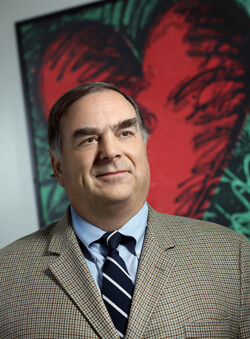Cardiovascular Report
January 6, 2014

“It was a major operation. It took me several months to recover,” says Cole, now 18.
However, two years later, the function of the donor pulmonary homograft began to deteriorate, causing Cole’s heart to work harder. Fortunately, by the time Cole needed a new pulmonary valve, Johns Hopkins pediatric cardiologist Richard Ringel was among the first clinicians in the country to offer a minimally invasive new procedure and a new device to replace pulmonary valves in the cath lab rather than in the OR.
“My recovery was much quicker compared with the operation I had when I was 12,” says Cole. “I have lots of energy now, and I can keep up with my friends. It has definitely made a big difference.”
Cole’s experience is an example of the many refinements that have been made in treating congenital heart problems since the world’s first “blue baby” operation was performed at Johns Hopkins in 1944.
The minimally invasive valve procedure is also helping people born with tetralogy of Fallot. Although the blue baby operation was a lifesaving turning point, in the decades that followed, it became clear that many patients would need subsequent procedures.
“Children born with tetralogy of Fallot have a pulmonary valve that’s too small or badly obstructed, and we need to create an opening, sacrificing the valve to get over the obstruction,” says Johns Hopkins Cardiac Surgery Director Duke Cameron. “We’ve learned that over time, the opening we created is leaking, and the right side of the heart is struggling.”
Because of that, Cameron says it’s important to replace the pulmonary valve before the regurgitation causes the heart to become enlarged and weak. That experience and knowledge have influenced how the operation for tetralogy of Fallot is now performed. “Today, we bend over backwards to preserve the patient’s own valve,” says Cameron. “It’s a balance to tolerate the slight blockage in order to avoid a lot of leakage down the road.”
Among the keys for further refining treatment for congenital heart defects, says Cameron, is evaluating outcomes through databases that combine the experience of many large programs. Cameron has recruited cardiac surgeon Marshall Jacobs to coordinate outcomes research and share experience and expertise across the congenital heart surgery programs at The Johns Hopkins Hospital, All Children’s Hospital Johns Hopkins Medicine in St. Petersburg, Fla., and Florida Hospital for Children in Orlando.
“Better medical and surgical techniques and greater understanding of the disease processes have led to a much improved outlook and quality of life,” says Jacobs. “There are now as many adults living with congenital heart disease as there are infants and children. Our goal is to develop ways to provide even better care of these patients.
